Key takeaways
- Improvisation in music is a spontaneous form of expression that fosters a unique connection between musicians and their audience, creating shared experiences.
- Chick Corea redefined jazz fusion through innovative techniques like modes, call and response, and complex rhythms, inspiring many musicians in the process.
- Key lessons from Corea include the value of spontaneity, the power of collaboration, and turning mistakes into creative opportunities.
- Incorporating Corea’s techniques encourages exploration of new musical landscapes, enhancing both personal expression and group dynamics in performances.
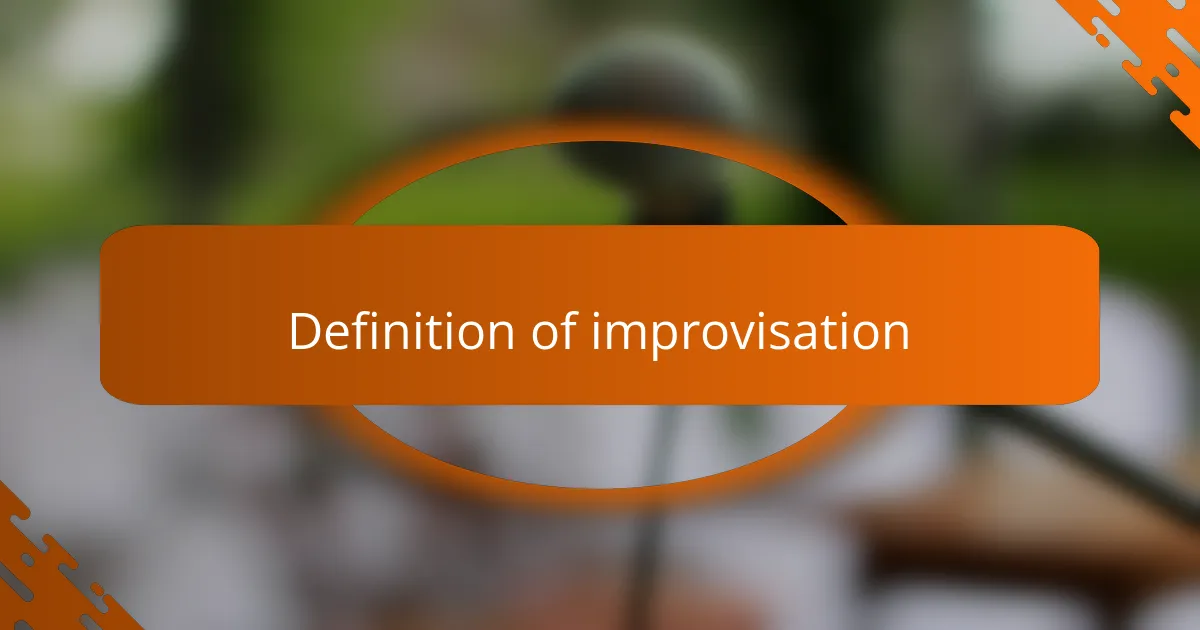
Definition of improvisation
Improvisation, in music, is the spontaneous creation of sound while performing. It’s like having a conversation with your instrument without a script. I remember hearing Chick Corea’s work for the first time; his ability to effortlessly weave melodies in real-time left me spellbound. It’s as if he was tapping into an emotional reservoir, pulling out feelings and thoughts, and sharing them through his music.
When I think of improvisation, I see it as a dance between the musician’s intent and the audience’s energy. It’s a moment where anything can happen. Chick’s improvisations often felt like a journey, where one could hear the shifts in mood—joyful crescendos transforming into contemplative whispers. This aspect of improvisation excites me deeply, as it taps into a universal human experience.
Here’s a simple comparison table that highlights different aspects of improvisation:
| Aspect | Definition |
|---|---|
| Spontaneity | Creating music spontaneously without pre-composed plans |
| Emotional Expression | A way to convey personal emotions and feelings through music |
| Interaction | A dynamic exchange between musicians and audience or fellow players |
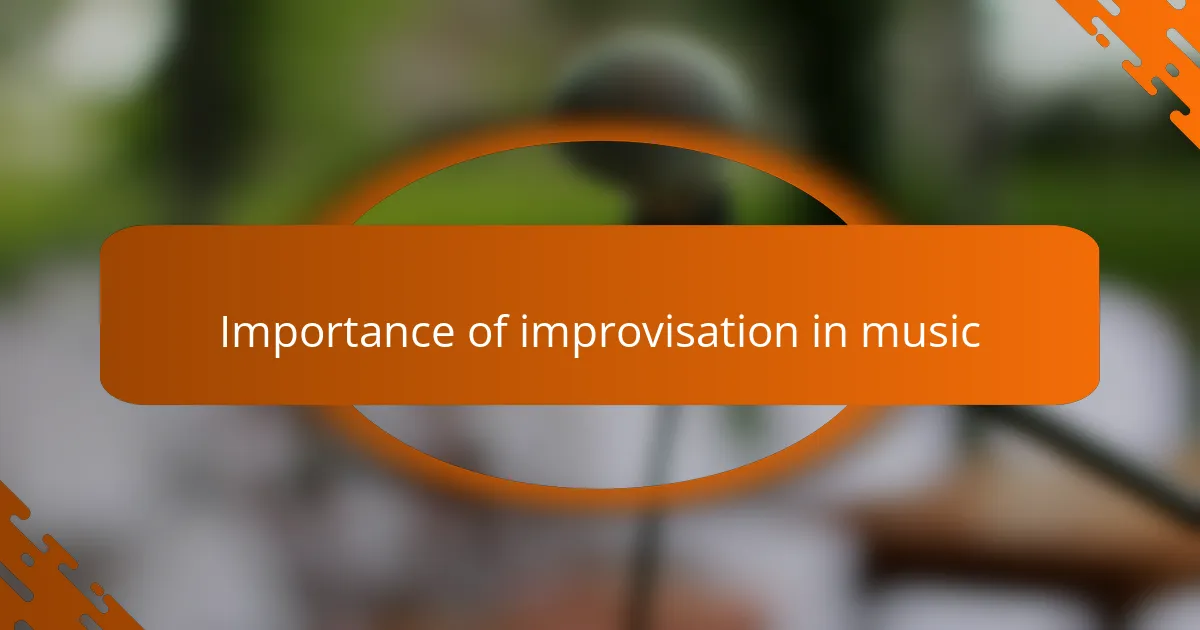
Importance of improvisation in music
Improvisation is the heartbeat of music. It allows musicians to express themselves in the moment, creating unique experiences that can never be replicated. I’ve found that every time I pick up my instrument and play without a script, I discover something new about myself and my emotions. Isn’t it fascinating how a simple note can evoke a memory or a feeling that you thought was long buried?
One of the most powerful aspects of improvisation is its ability to connect performers with their audience. When I see an artist like Chick Corea improvise, it feels like he’s inviting everyone into an intimate dialogue, almost as if he’s sharing his innermost thoughts and vulnerabilities. That connection heightens the musical experience, turning a performance into a shared journey, where each listener interprets the music in their own unique way.
Moreover, improvisation fosters creativity in other areas of life beyond music. It teaches us to think on our feet, embrace risk, and accept mistakes as part of the process. I often reflect on how improvisational moments in my musical journey have mirrored life’s unpredictability, encouraging me to be adaptable and open-minded. How can we find joy in the unknown if we never dare to improvise?
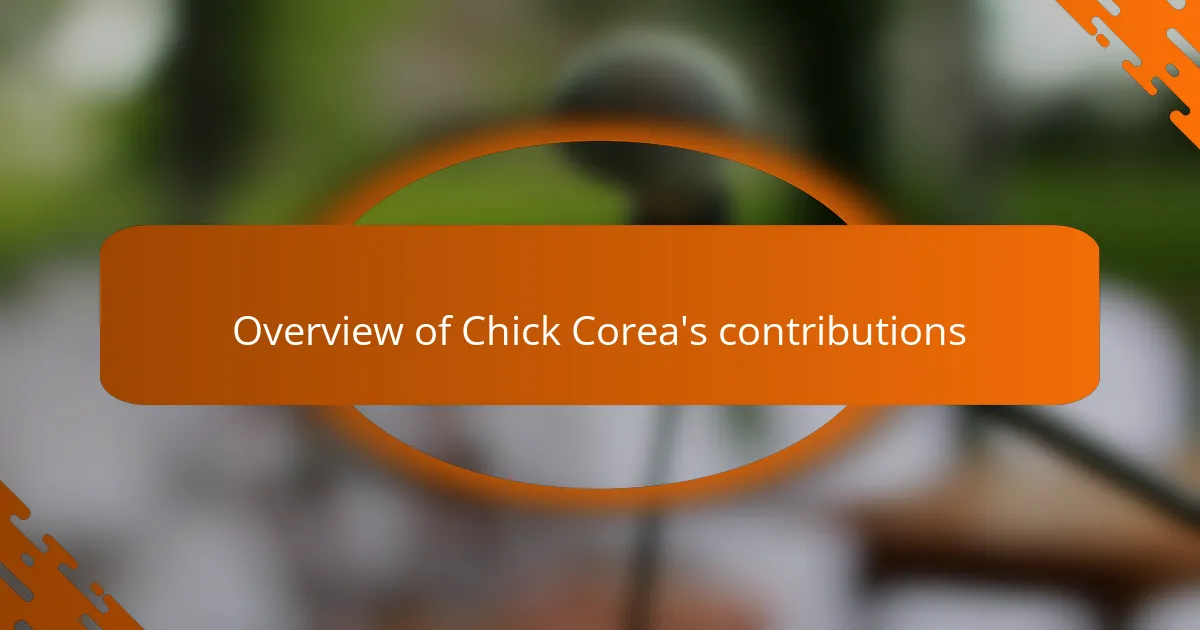
Overview of Chick Corea’s contributions
Chick Corea’s contributions to jazz and contemporary music are nothing short of remarkable. His innovative approach to improvisation not only reshaped jazz fusion but also inspired countless musicians, including myself. I remember the first time I listened to his album “Return to Forever”; the way he blended electric and acoustic elements opened my eyes to new possibilities in my own music.
In addition to his influential recordings, Corea’s extensive collaborations, often spontaneous in nature, showcased his incredible ability to adapt and communicate through music. His performances felt like conversations, where each note was a word, fostering a unique connection with audience members.
- Credited as a pioneer in jazz fusion, blending jazz with rock and Latin influences.
- Co-founded the influential band Return to Forever, which pushed musical boundaries.
- Collaborated with iconic artists including Miles Davis, Herbie Hancock, and Bobby McFerrin.
- His compositions, like “Spain” and “La Fiesta,” became standards in the jazz repertoire.
- Renowned for his commitment to education and mentorship of aspiring musicians.
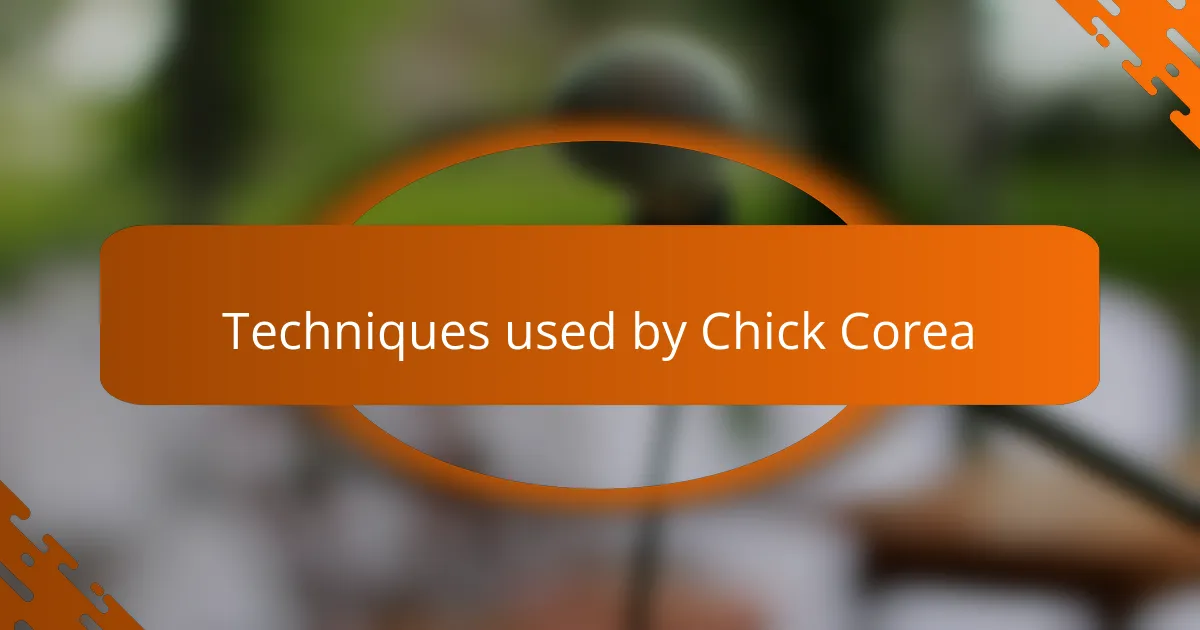
Techniques used by Chick Corea
Chick Corea’s approach to improvisation is truly captivating. He often employs modes and scales that give his music a distinctive color and feel. For instance, I’ve noticed how effectively he uses the whole-tone scale, which creates a dreamlike quality that can transport listeners to another world.
Another fascinating technique he masterfully utilizes is call and response between instruments. I’ve found this creates a dialogue-like atmosphere in performances, making the music feel alive and spontaneous. It’s almost like he’s inviting each musician to join the conversation, which always brings an exciting layer of unpredictability to his works.
Lastly, Corea’s ability to blend complex rhythms and time signatures adds an intriguing dynamic to his improvisation. Personally, I find this aspect especially exhilarating; it challenges the listener’s expectations while simultaneously highlighting his technical prowess. Many times, I’ve found myself tapping along, completely drawn into the groove he establishes.
| Technique | Description |
|---|---|
| Modes and Scales | Creates unique tonal colors, like the use of whole-tone scales for dreamlike effects. |
| Call and Response | Fosters a conversational atmosphere, engaging musicians in a dynamic interplay. |
| Complex Rhythms | Utilizes varied time signatures to challenge listeners and showcase technical skill. |
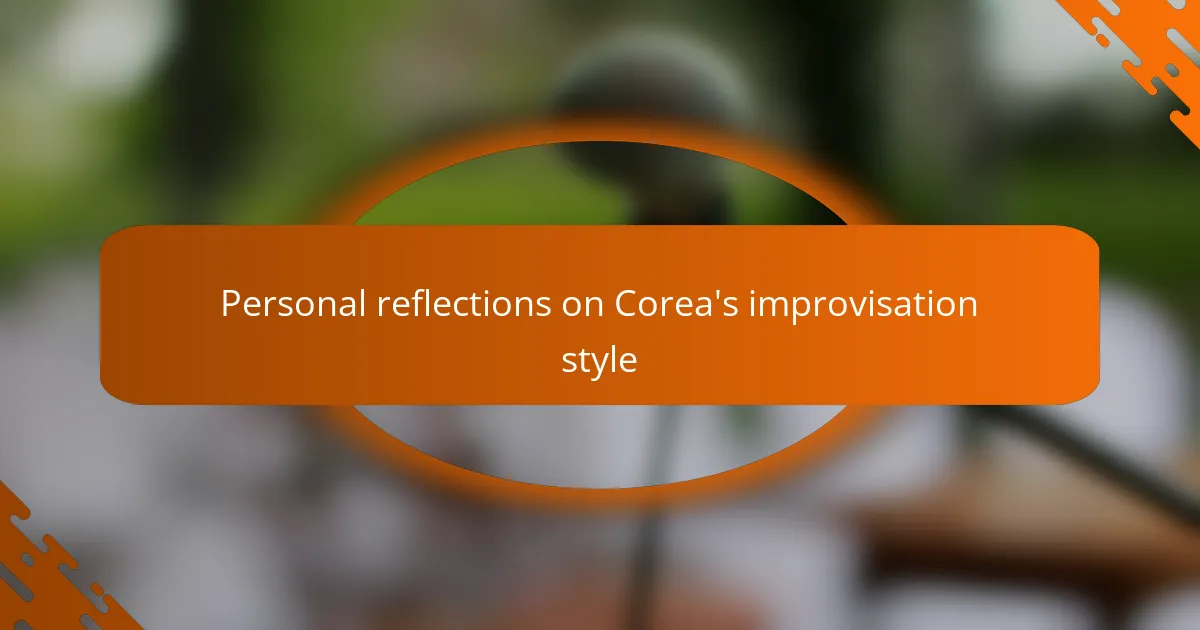
Personal reflections on Corea’s improvisation style
Chick Corea’s improvisation style has always stirred something deep within me. I remember the first time I listened to his work; it felt like being pulled into a vibrant conversation filled with unexpected twists and turns. His ability to blend elements of jazz, classical, and even Latin music creates an almost magical experience, where every note feels like a revelation.
Whether he’s playing solo or with a band, Corea’s improvisation often displays a remarkable balance of spontaneity and structure. I admire how he seems to anticipate his fellow musicians’ movements while simultaneously paving his own path. It’s this interplay that inspires me to explore my own improvisational skills and reminds me of the beauty of pure musical expression.
- Corea often uses motifs that evolve throughout a piece, providing a familiar thread amidst intricate variations.
- His playful exploration of rhythm often keeps the listener on their toes, revealing the excitement inherent in improvisation.
- I recall feeling chills when he seamlessly transitioned between serene melodies and intense, faster passages, making for a captivating auditory journey.
- Corea’s willingness to experiment invites us all to embrace the unexpected in our own creative endeavors.
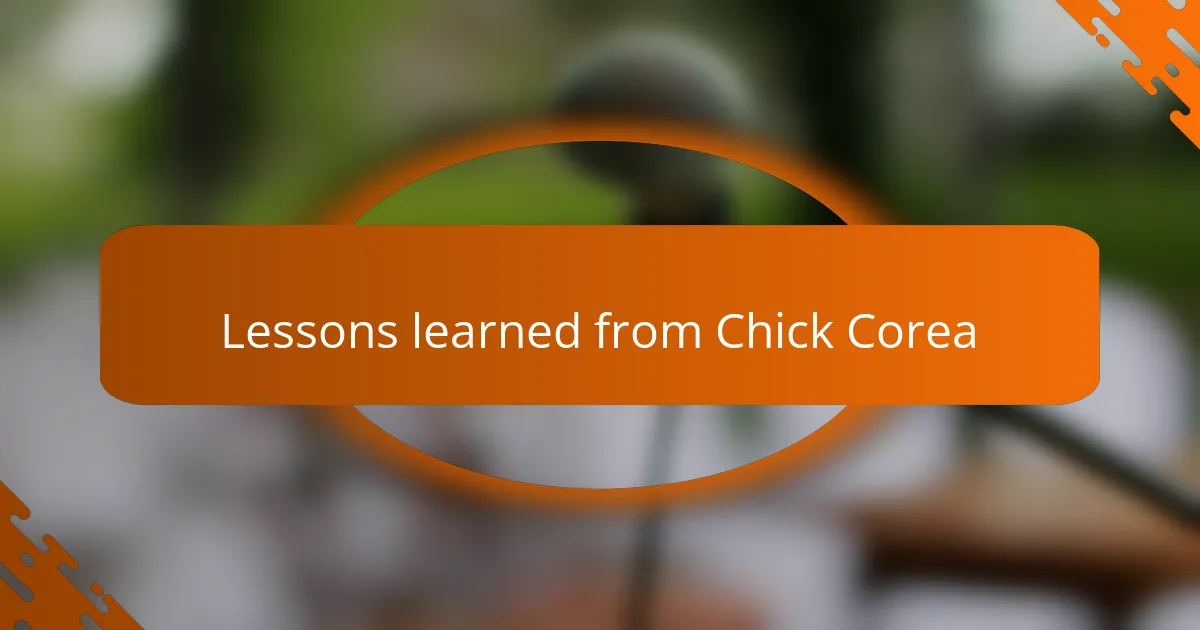
Lessons learned from Chick Corea
One of the most significant lessons I’ve learned from Chick Corea is the value of spontaneity. His ability to weave intricate melodies on the spot demonstrates the beauty of being present in the moment. I recall a time while jamming with friends, where I channeled his improv spirit, letting go of my fears and embracing the unexpected notes that flowed from my fingers.
Another insight I gained from Corey is the importance of collaboration. His musical partnerships often resulted in breathtaking exchanges of creativity. I remember being part of a group performance where listening to others transformed our sound entirely, much like Corea shared the stage with various artists, enriching each piece they created together.
Lastly, Corea taught me that mistakes can lead to extraordinary discoveries. During my early piano days, I often stumbled over challenging passages. Inspired by his journey, I learned to turn those missteps into unique embellishments, much like how Corea would transform a wrong note into a new groove.
| Lesson | Example from Chick Corea |
|---|---|
| Spontaneity | Improvising beautiful melodies in the moment |
| Collaboration | Creating magic through partnerships with other artists |
| Turning Mistakes into Art | Transforming wrong notes into unique soundscapes |
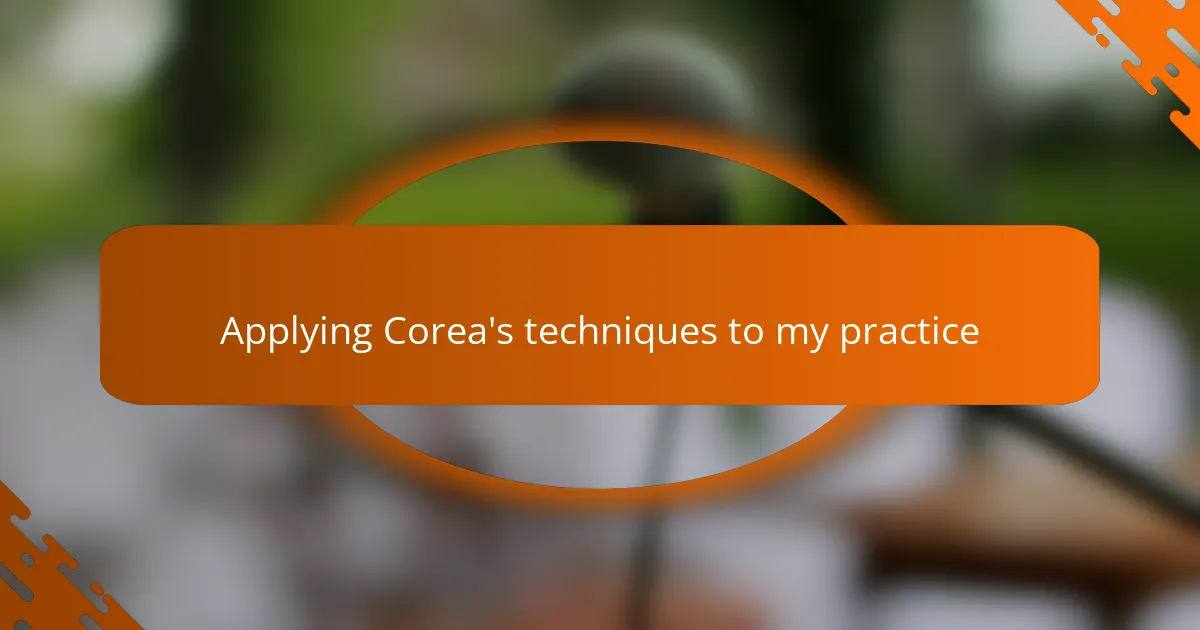
Applying Corea’s techniques to my practice
Embracing Chick Corea’s techniques has fundamentally shaped my practice. I’ve started focusing on the whole-tone scale, which allows me to explore a sense of dreaminess in my improvisations. There’s something liberating about letting my fingers follow this scale; it encourages me to break free from conventional patterns and express feelings that are sometimes hard to articulate.
I’ve also begun to incorporate call and response in my jam sessions. It’s fascinating to see how this technique fosters a real dialogue among musicians. I recall a memorable night when I played with a group, and as we engaged in this call and response, it felt like we were not just creating music; we were having a conversation that the audience could join in on. How incredible is that?
Lastly, I find myself experimenting more with varied time signatures, as I’ve seen Corea do so brilliantly. When I play with complex rhythms, I notice that it changes the energy in the room. The other musicians respond differently, and it makes the entire experience feel dynamic and alive. I often reflect, how can pushing the boundaries of rhythm lead to new creative landscapes? For me, it’s a thrilling journey that deepens my appreciation for both improvisation and the musicians I collaborate with.